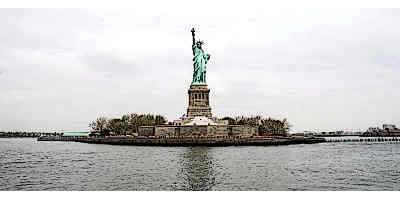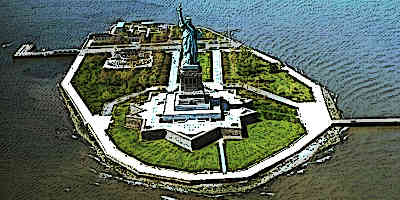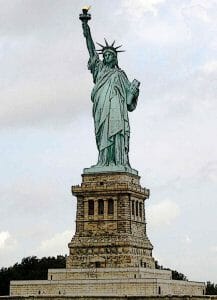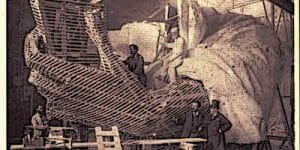Liberty Island – 12 Acre Site
Liberty Island is an island located in the bay between the New York and New Jersey.
The island is famously known for being home to the iconic ‘Statue of Liberty‘. Originally named Bedloe Island, the island was privately owned at one time.
It was later used as a military base and subsequently purchased by the federal government.
The island is around 12 acres in area and is frequented by a large number of visitors on an annual basis.
Ownership Dispute between States
The waters around the Island are under the jurisdiction of the state of New Jersey.
However, the island itself falls under the jurisdiction of the state of New York. This has caused disputes between the two states.
New Jersey has raised the issue several times in a bid to gain jurisdiction over Liberty Island or get co-jurisdiction along with New York. However, this attempt has not failed so far.
The island itself is considered federal property and has been so since the early 19th century.
Early History and Bedloe Island
The Native American Lenape people originally lived in the region around the Island.
When the Dutch settlers arrived, they brought the island under their settlement.
When the English took over the Dutch colony of New Amsterdam, the island passed to English control.
It was initially granted to Captain Robert Needham by the English governor.
Needham later sold it in 1667 to Isaac Bedloe and the island was named after him to ‘Bedloe Island’.
It passed through the hands of various private owners before it was purchased by the City of New York in 1756.
Under the Federal Government
After the United States had come into being, a need was felt to fortify New York by establishing a base on the Island.
To this end, the island was purchased by the federal government in 1800.
A fort with an 11-point star shape was constructed on the island.
It was named Fort Wood and played a role as a defensive fortification against the British during the War of 1812.
Although the fort remained an important military base during the early 19th century, its importance had declined by the last quarter of the century.
It became obsolete and abandoned. The island, located at a place where immigrants arriving at New York can easily see it, was then chosen as the site for the ‘Statue of Liberty’.
The Statue of Liberty
In 1885, the Statue of Liberty arrived in the United States.
The statue was a gift to the people of the United States from France.
Frederic Auguste Barholdi, the sculptor of the statue, recommended the Liberty Island as the site for the statue’s erection.
The U.S. government consented and preparations were made on the island for the statue.
A special pedestal was constructed on which to erect the statue.
It was finally erected and unveiled in a ceremony in 1886.
The island was then renamed from ‘Bedloe Island’ to ‘Liberty Island’. Today, the National Park Service has jurisdiction and management of the entire island.
Liberty Island Quick Fun Facts:
- Liberty Island is home to the Statue of Liberty.
- Liberty Island was originally known as ‘Bedloe Island’.
- Liberty Island was originally an obsolete and abandoned Fort.
We hope you have enjoyed reading this article on ‘Liberty Island’ If you are interested in learning more about Liberty Island and the statue of liberty please see additional article links at the bottom of this page or look for resource links within the body of this Liberty Island article!
Learn more about Liberty Island at Wikipedia
- Statue of Liberty
- 4 Astounding Statue of Liberty Conspiracies
- Amazing Statue of Liberty History
- Amazing Statue of Liberty Torch 145 Year History!
- Famous Parts Statue of Liberty
- Freedom – 7 Ray Crown of Liberty
- Interesting Statue of Liberty Timeline – 1865 – 1986
- Liberty Island – 12 Acre Site
- Statue of Liberty 33 Amazing Facts
- Statue of Liberty Construction ** Awe-Inspiring ‘Lady Liberty’
- Statue of Liberty Famous People



